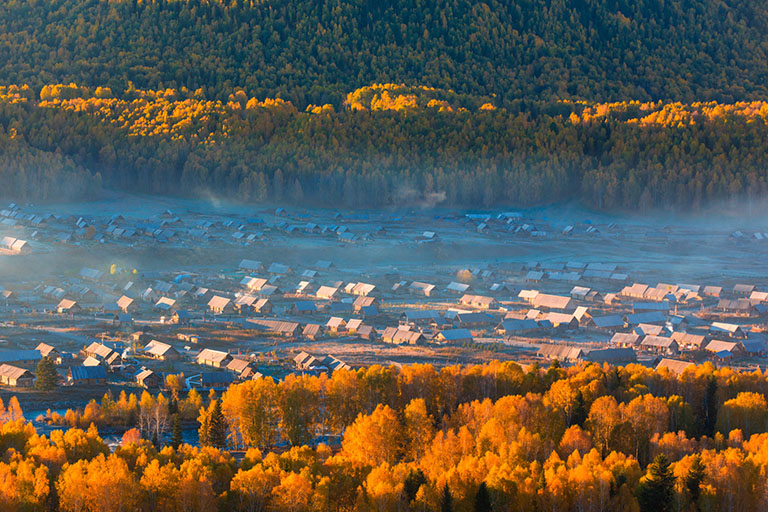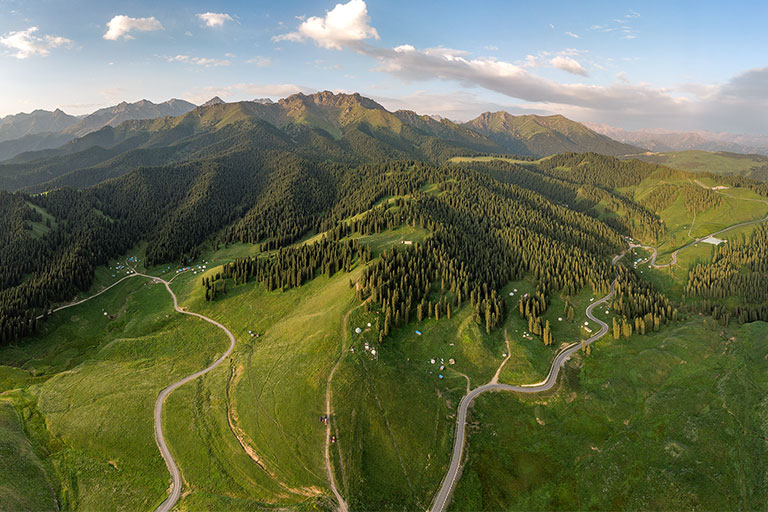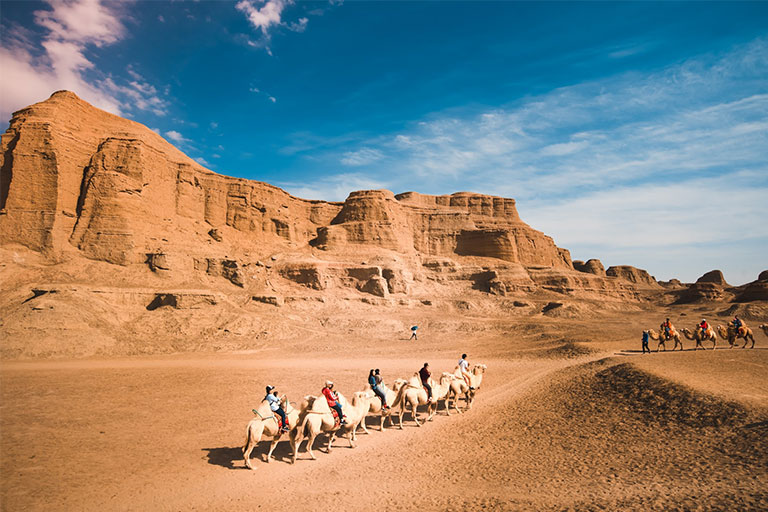Xinjiang Destinations | Places to Visit in Xinjiang 2025
Xinjiang, covering an area of 1,660,000 square kilometers, is the largest province in China. Thanks to its vast land, it possesses various kinds of landforms that have become amazing scenery for travelers. Additionally, it is an important part of the Silk Road, which linked China with the western world in ancient times. Whether you are interested in natural landscapes such as mountains, lakes, deserts, valleys, forests, grasslands, etc., or fond of cultural wonders like religious temples, ancient ruins, historical cities, traditional bazaars, etc., your expectations can be absolutely met. Xinjiang can be divided into the northern part and the southern part by the Tianshan Mountain (Heavenly Mountain). Generally, Northern Xinjiang is more renowned for its pristine nature, while Southern Xinjiang is famous for Uighur culture. First-time visitors usually explore Xinjiang's golden triangle cities - Urumqi (in Northern Xinjiang), Turpan (in Northern Xinjiang), and Kashgar (in Southern Xinjiang) where both nature and culture can be savored. Of course, there are many other destinations to experience. Here we have listed Top 12 Xinjiang Destinations to go to, and each of them has its unique flavor. Just feel free to pick your favorite destinations and customize a Xinjiang tour according to your own style.
Quick Jump to:
- Top 1: Kashgar
- Top 2: Turpan
- Top 3: Altay (Kanas)
- Top 4: Urumqi
- Top 5: Hotan
- Top 6: Taklamakan Desert
- Top 7: Ili
- Top 8: Bortala (Sayram Lake)
- Top 9: Changji
- Top 10: Karamay
- Top 11: Aksu (Kucha)
- Top 12: Hami

Kashgar Old City © 文刀四火 / mafengwo

Karakul Lake © 旅拍玩家 / mafengwo
Someone says that if you plan to visit one place in Xinjiang, just visit Kashgar. Located in the westernmost part of China, it once was a busy post for traders, officials and travelers on the Silk Road and now is a witness of the fusion of eastern and western cultures. The multi-ethnic groups and different religious beliefs are still alive in Kashgar. Visiting different historical and cultural sites in Xinjiang, you will fully admire the charm of Kashgar. In addition to cultural fun, you can also admire the incredible landscape of Pamirs Plateau. Besides, Kashgar is also a transfer hub in Southern Xinjiang, and it receives flights from several domestic flights, including Beijing, Xian, Shanghai, Chengdu, Nanjing, Urumqi, etc.
In Kashgar, you really have a lot of things to see and to do. Kashgar Old City is the soul of Kashgar and you can lose yourself in the neighborhood with crisscross lanes. Century-old Teahouse in Kashgar Old City is a must that you can see the local people's daily life. Id Kah Mosque is Xinjiang's biggest mosque with many typical Islamic buildings. Abakh Hoja Tomb is a big family graveyard with featured architecture as well. Don't miss the weekly bazaars, which are the most interesting sights in Kashgar.
Apart from Kashgar City, many travelers travel to Tashkurgan - the essence of Kashgar. It is a significant historical town on the ancient Silk Road, which still keeps its old tradition. On the driving trip from Kashgar City to Tashkurgan, you will meet Baisha Lake, Karakul Lake, Muztagh Ata, etc., and many other picturesque scenery.
- • Recommended Trip Length: 3-5 days
- • Best Time to Visit: All the Year Around

Jiaohe Ancient City © 过客 / mafengwo

Kumtag Desert © 老乐 / meipian
Located in the central part of Xinjiang and 167 km to Urumqi, Turpan is another top destination. It is known as the Hottest City in China, and its historical highest temperature reaches 49.6°C. In addition to the highest temperature, it has the lowest altitude. The surface of Aiding Lake in Turpan is about 154.31 meters below Sea Level. It is also the hometown of grapes that you taste the best grapes easily in Turpan. Since 2,000 years ago, Turpan also played a significant role in policy, economy and culture. It was also an important outpost along the Silk Road. For culture-seekers, Turpan is a good place worthy of at least 2~3 days' exploration.
There are lots of attractions in or around Turpan City. Jiaohe Ancient City is a time-honored city ruins in Turpan and it is recognized as the largest, oldest and best-preserved earth building city in the world. It is recommended to visit this place in the early morning or late night to avoid the heat. In spite of the hot weather, people still live in Turpan because of the Karez System - the ingenious water system. Don't miss Karez Folk Custom Garden to explore the Karez System better. Flaming Mountain, immortalized in the Chinese classic Journey to the West, is another must for a Turpan trip. Flaming Mountain Grand Canyon is the best place to enjoy the featured landscape of Flaming Mountain. You can also visit Bezeklik Thousand Buddha Caves, which is just located on the cliffs of Flaming Mountain, to take a view of the exquisite murals on the stone wall. If you want to see some natural views, just go to Kumtag Desert - the world's nearest desert to the city.
- • Recommended Trip Length: 2-3 days
- • Best Time to Visit: May to October

Autumn Scenery of Hemu Village © GOOM果果 / mafengwo

Autumn Scenery of Moon Bay of Kanas Lake © GOOM果果 / mafengwo
Located in the hinterland of Eurasia, Altay is an alluring destination in Northern Xinjiang and it enjoys a fabulous ecological environment. Many photographers are attracted here to capture the most astonishing autumn colors and the peaceful villages in mist. Though scenic beauty is the biggest highlight of Altay, the diverse minority culture and customs are worthy of your appreciation. Altay also provides a winter wonderland and many skiers come to enjoy some of the best ski resorts in China. Therefore, you can find something to delight yourself no matter which season you visit Altay.
Among Altay's beautiful sights, Kanas must be the premier sight. In fact, Kanas is a huge geopark with many small attractions to enjoy, including the gem-like lake with mysterious legends, lush birch forests enveloped in bright colors in autumn, and several old villages where Tuva ethnic people live in. Hemu Village is the most beautiful village in Kanas National Geo Park and the Paradise for Photography. For nature lovers and photographers, there are many other places to satisfy your ambitions. Recommended ones include Wucaitan (Rainbow Beach) - a beach with colorful hills near Kanas Lake, Keketuohai (Koktokay National Geopark) - a marvelous canyon located in Fuyun County, Wucaicheng (Colorful City) - the shooting location of the famous movie Crouching Tiger, Hidden Dragon.
- • Recommended Trip Length: 3-4 days
- • Best Time to Visit: June to December

Xinjiang International Grand Bazaar © 一切旎好 / mafengwo

Nanshan Passture © 迷途的小柒 / mafengwo
Many travelers start their Xinjiang tours in Urumqi - the provincial capital city which can be reached easily. It is convenient to take domestic flights from the major cities in China, such as Beijing, Shanghai, Guangzhou, Chengdu, Xian, Shenzhen, Xining, Lanzhou, Lhasa, Ngari (Tibet), Harbin, Hohhot, etc., or take high speed trains from Lanzhou, Xining, Zhangye, Dunhuang, etc. to Urumqi. Besides, it also operates regular flights and trains to many other cities in Xinjiang. Therefore, Urumqi is a very great tourist distribution center in Xinjiang, especially in northern Xinjiang.
In fact, Urumqi not only has convenient transportation and better accommodation, but also has beautiful scenery and ethnic culture to admire as well. Nanshan Pasture, just located in the southern suburb of Urumqi, is a historical hunting pasture. In the pasture, you can feast your eyes on the verdant grassland and snow-capped mountains. If you want to take an overview of Xinjiang's history and culture, Xinjiang Regional Museum is a must. The ancient mummies collected in the museum are some visitors' favorites. In order to learn the old market culture of Xinjiang, don't miss Xinjiang International Grand Bazaar - the biggest bazaar in Xinjiang. It is also available to visit Red Hill Park to experience the local life and many locals are doing daily relaxing activities here. Moreover, Urumqi is a good gateway city to Heavenly Lake of Tianshan Mountain, which is a spectacular alpine lake with a beautiful reflection of Bogda Peak.
- • Recommended Trip Length: 2-3 days
- • Best Time to Visit: May to October

Hotan Museum © Wanderer / mafengwo

Niya Ruins © travelxj
Hotan (Hetian in Chinese pinyin) is located in the south corner of Xinjiang. Many travelers learn its name because of Hotan Jade (Nephrite Jade) which is a light-colored jade listed in Four Most Famous Jades in China. Bordering Tibet in the south and Kashgar in the west, it is a multi-ethnic area. Except for Uygur, there are Han, Hui, Kzak, Kigiz and many other ethnic groups, making it a wonderful city to explore the diverse culture of different groups. Historic relics are another highlight that history and culture lovers find difficult to resist.
As you arrive in Hotan City, Hotan Museum must be a good idea to learn about the past of this city. There are 3,272 sets and 9,553 pieces of collections exhibited in the museum and there is an exhibition hall for Niya Site - the former site of the Ancient Jingjue Kingdom to give travelers a better understanding of the lost civilization. For travelers who like to try different food, you can't miss Hotan Night Market where you can get a taste of many local snacks. If you are interested in experiencing local atmosphere or purchasing some souvenirs, just visit Hotan Bazaar. If you travel by private car, we suggest you take a trip along Hotan-Alar Desert Highway which is an awful desert road.
- • Recommended Trip Length: 1-3 days
- • Best Time to Visit: May to October

Taklamakan Desert Scenery © 托尼star / mafengwo

Taklamakan Desert Highway © CrazyWolfkin / mafengwo
Taklamakan Desert (Taklimakan Desert) is the largest desert in China and it covers about 20% of a total area of Xinjiang, equaling to the same size as Shanghai. Located in the center of Tarim Basin, it starts from Korla in the East, Kashgar in the west, Hotan in the South, and Aksu in the north.
There are two national roads - G217 and G216 crossing it. G217 is the famous Duku (Dushanzi-Kucha) Road, which passes through many beautiful tourist attractions (including Dushanzi Grand Canyon, Nalati Grassland, Bayanbulak Grassland, Tianshan Mystery Grand Canyon, etc.) and is known as Landscape Road Along the Spine of the Tianshan Mountains. G216, starting from Altay and reaching Baluntai Town in Bayingolin, is the other project to conquer the Desert of Death. Apart from Taklamakan Desert, it also passes through Gurbantunggut Desert. No matter which road you choose to drive on, you can get a wonderful journey across Taklamakan Desert.
Apart from a driving journey, it is also available to enjoy the desert view of Taklamakan in Luobu People's village. The local culture and folk customs in the village also deserve your time.
- • Recommended Trip Length: 1-2 days
- • Best Time to Visit: May to October

Human Grassland in Karajun Grassland © 雨中筑梦/meipian

Beautiful Apricot Valley in Spring © 橙小橙橙/mafengwo
Though not as famous as other top destinations in Xinjiang, Ili (Yili in Chinese pinyin) is a fairyland to escape the bustle of the city and indulge in nature. With plenty of rainfall and humid weather, it is praised as the Wet Island in the Green Sea. The coverage rate of its grassland and forest vegetation reaches 67.7%. Visiting Ili in June ~ October, you will not only savor the captivating landscape, but also enjoy a buffet of fruits.
When speaking of Ili, many travelers may think of a painting with vast grasslands. Nalati Grassland, praised as grassland in the sky, is one of the most beautiful grasslands in China. With endless ridges stretching to the sky, Nalati Grassland gives you quite a different appearance from the flat grassland in Inner Mongolia. Karajun Grassland is an alpine grassland worthy of 1 ~ 2 days' time. Though it is less-known among tourists, the human grassland view makes everyone unforgettable. Tangbula Grassland and Zhaosu Grassland are two other top grassland in Ili, and the peak season to visit them is summer. Besides grassland, you can visit Guozigou Valley to see the majestic bridge, Apricot Valley (blooming in March to early May)to appreciate a large sea of wild apricot flowers. Some travelers also get to Sayram Lake from Ili because of the close distance.
- • Recommended Trip Length: 2-3 days
- • Best Time to Visit: May to October, especially June to August

Sayram Lake in Summer © slmhjq

Snow-capped Peaks in Sayram © travelxj
Literally meaning “silver grassland” in Mongol, Bortala is a low-key destination embraced on three sides by mountains. Due to its special geographic position, it is endowed with four distinct seasons and features seasonal scenery.
Most travelers visit Bortala to view the incredible scenic splendor of Sayram Lake - Xiniang's largest alpine lake and largest lake above sea level. There are famous scenes telling the best sightseeing that you can enjoy in your Sayram trip. In addition to the lake view, you can feast your eyes on the verdant forests, snow-capped peaks, thriving grasslands, colorful flowers. If you want to enjoy the best scenery at the best time, we suggest you visit Sayram Lake in May ~ September, especially in summer (June ~ August) when the subalpine meadows are full of wild flowers in different colors. In order to offer you an efficient experience, you can choose different ways to travel around the lake, including sightseeing car, biking and self-driving. Except for Sayram Lake, you can visit Aibi Lake to savor the unique wetland landscape, Guaishi Valley (Strange Stone Valley) to admire lots of oddly-shaped rocks and Bortala Museum to take a view of local history, culture and folk customs.
- • Recommended Trip Length: 1-2 days
- • Best Time to Visit: May to October, especially June to September

Heavenly Lake of Tianshan © 陈巍伟 / mafengwo

Jiangbulak Grassland © 过客 / mafengwo
Changji is located at the northern foot of Tianshan Mountains and the southeastern edge of the Junggar Basin. Bordering Mongolia in the northeast, it is the place that the new north route of the Silk Road to central Asia and European countries must pass through.
Changji has unique tourist resources attracting numerous visitors. The top attraction in Changji is Heavenly Lake of Tianshan Mountain (Tianchi)- a UNSCO World Natural Heritage site. The biggest highlight of Tianchi is its natural landscape consisting of lakes, snow peaks, forests, valleys, glaciers, etc. It is available to take a boat to closely see the crystal clean water or take a cable car to Mount Maya to catch a panoramic view of the lake and surrounding peaks. Jiangbulak Scenic Area, located in Qitai County, is another beautiful place to appreciate the natural view. It has 7 water pools in the main scenic area which look like the Big Dipper from a distance. Another splendid sight in Qitai County is Mulei Populous Euphratica Forest for the amazing populus euphratica forest sightseeing and splendid autumn colors. If you want to see more wild nature, Gurbantunggut Desert is recommended. Though it is a primitive, barren and borderless desert, it hosts a natural botanical garden with some desert plants.
- • Recommended Trip Length: 1-2 days
- • Best Time to Visit: All year round, especially May to October

Karamay Ghost City © 阿拉斯古 / mafengwo

Dushanzi Grand Canyon © 飞翔 / mafengwo
Meaning black oil in Uighur, Karamay is named after Heiyou Mountain (Black Oil Mountain) which is the place where the important oil seedlings outcrops in the oil field. As the first oil fields were exploited here, Karamay became a modern city. However, it is not only a city with abundant oil resources, but also an awesome tourist destination with rich tourist resources.
Among Xinjiang's destinations, Karamay must be one of the best places to delight your eyes on unique scenery and get some excellent shots. Karamay Ghost City (Wuerhe Ghost City) is a jaw-dropping Geopark getting its name because the winds and sandstorms roar through the rock like howling ghosts. Many shutterbugs are attracted here to photograph the unique Yardang landform which was formed by wind and rain after millennia. Photographers who visit Karamay seldom skip Dushanzi Grand Canyon which is recognized as the Most Beautiful Road in China by National Geographic. The most striking sight of Dushanzi Grand Canyon is the weathered mud sculpture on the cliffs on both sides of the river. If you travel to Karamay in October, don't miss Wu'erhe Populus Euphratica Forest which is just about 30 km away from Karamay City. Entering this old forest, you will be surprised by this rare species with thick trunks, featured branches and golden leaves.
- • Recommended Trip Length: 2-3 days
- • Best Time to Visit: May to early October

Kucha Palace © 在路上... / mafengwo

Cave No.8 of Kizil Caves © 悦目赏心de古风遗韵 / Sina Blog
Aksu is located at the southern foot of the Tianshan Mountains in the Xinjiang Uygur Autonomous Region and the northern edge of the Tarim Basin. It is named after the Aksu River. The Aksu area not only has beautiful natural scenery, but also has a cultural landscape with ethnic characteristics. The "Quchi Ancient Kingdom" site in the 36 countries of the Western Regions is in Kucha (Kuche, Kuqa) - travelers' favorite destination in Aksu. The ancient Silk Road also passes through Aksu and many cultural heritage sites can be found here.
In Kucha, there are more than 50 historical & cultural sites. Kumurula Caves is a big Buddhist caves group dating from the 5th to the 11th centuries. There are 112 cave temples survived and the murals on the walls of the caves show both western style and local artistic style. Kucha Palace is the place where the last prince of the country lived. Here, visitors can get a glimpse of the prince's demeanor, and listen to the prince's story. Other historical sites include Qiuche Ancient City Ruins, Kucha Grand Temple, Ruins of Subashi Buddhist Temple, etc. The natural wonders in Kucha are also remarkable. Kucha Grand Canyon covered by reddish brown rock in various shapes is rather majestic and precipitous. Kizilya with the peculiar mountain peaks really shows the power of nature. In addition to Kucha, there are many other places to visit in Aksu, including Kizil Caves of the Thousand Buddhas - the Earliest Buddhist Grottoes in China, nearly 260 years earlier than Dunhuang Mogao Caves. There are 339 Buddhist caves preserved and 6 caves are open to tourists.
- • Recommended Trip Length: 2-3 days
- • Best Time to Visit: May to October

Barkol Lake © travelxj

Dahaidao Yardang Landscape © travelxj
As an important town on the ancient Silk Road, Hami enjoys a long history and culture as well as attractive humanities and natural landscape. It combines the nature and climate of both Northern and Southern Xinjiang, and was praised as the Microcosm of Xinjiang. Hami is an oasis in the desert to taste sweet fruits (especially sweet cantaloupes and grapes) because of the long sunshine duration. Located in the eastern part of Xinjiang, it is also the gateway of inland China to Xinjiang. It is a classic tour from Lanzhou to Urumqi via Xining, Zhangye, Dunhuang, Hami and Turpan.
The attractions in Hami won't disappoint you. Dahaidao is where you must visit if you want to explore the ancient castles, beacons, post stations, prehistoric human settlements, fossil mountains, and many other geographical landforms like nowhere else in the world. Barkol Prairie, the second largest grassland in Xinjiang, is a good place for summer resorts. There are endlessly-stretching mountains, green grassland, fresh air and flocks of herds and sheep, etc. Hami Tianshan Scenic Area is another place to admire the painting-like natural landscape, including ice glaciers, forests, grasslands, as well as singing sand mountains. For a better probe into the past of Hami, go to the informative Hami Museum to see the numerous collections including cultural relics from primitive society to the Ming and Qing Dynasties.
- • Recommended Trip Length: 1-2 days
- • Best Time to Visit: May to October
How to Plan A Xinjiang Tour
A longer Xinjiang trip is more recommended and worthwhile because of its large scale. A classic Xinjiang tour takes 6 ~ 8 days, including 2~3 days in Urumqi (Xinjiang Regional Museum, Nanshan Passture) and Heavenly Lake, 1~2 days in Turpan (Jiaohe Ancient City, Karez System, Bezeklik Thousand Buddhas... ), and 3 ~ 4 days in Kashgar (Kashgar Old City, Karakul Lake, Tashkurgan Fort...). Don’t miss Kanas - the God’s private garden, and it takes at least 3 full days to enjoy its beautiful lakes, bays, forests, rivers and villages.
☛ 8 Days Xinjiang Classic Tour (Urumqi - Turpan - Kashgar)
☛ 9 Days Kanas Lake Fairyland Tour from Urumqi
Many travelers prefer a Silk Road tour involving Gansu and Xinjiang discovery together. It takes about 2~3 days to explore Dunhuang highlights, 2~3 days to visit Zhangye essences and 1~2 days to enjoy Jiayugan landmarks. It is also recommended to spend 1 ~ day visiting Xining and Qinghai Lake.
☛ 10 Days Classic China Silk Road In-depth Tour
☛ 11 Days In-depth Wild Silk Road Adventure Tour
In fact, the Silk Road broke into three routes in Xinjiang, and they passed through many cities in Xinjiang. For adventurous travelers looking for something different along the glorious road, just spend about 2 weeks visiting legendary Turpan, Korla, Kuqa, Kashgar, Tashkurgan, etc.
☛ 13 Days In-depth Xinjiang Silk Road Adventure Tour
☛ 6 Days Qinghai Lake Zhangye Danxia Rainbow Mountains Tour
Many travelers visit Xinjiang for the extraordinary scenic beauty. It is easy to find some places to envelope yourself in nature or capture some excellent photography, such as grasslands, lakes, villages, and some other geographical wonders in 1 ~ 2 weeks.
☛ 10 Days Stunning Ili Apricot Blossom and Naraty Grassland Tour
☛ 11 Days Best Xinjiang Landscape Tour





























































